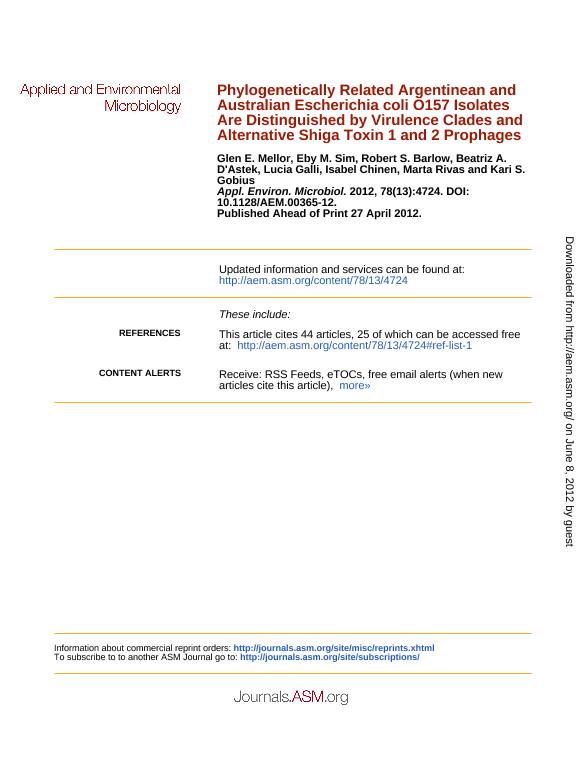Artículo
Phylogenetically related Argentinean and Australian Escherichia coli O157 isolates are distinguished by virulence clades and alternative shiga toxin 1 and 2 prophages
Mellor, Glen E.; Sim, Eby M.; Barlow, Robert S.; D'Astek, Beatriz A.; Galli, Lucía ; Chinen, Isabel; Rivas, Marta; Gobius, Kari S.
; Chinen, Isabel; Rivas, Marta; Gobius, Kari S.
 ; Chinen, Isabel; Rivas, Marta; Gobius, Kari S.
; Chinen, Isabel; Rivas, Marta; Gobius, Kari S.
Fecha de publicación:
07/2012
Editorial:
American Society for Microbiology
Revista:
Applied And Environmental Microbiology
ISSN:
0099-2240
Idioma:
Inglés
Tipo de recurso:
Artículo publicado
Clasificación temática:
Resumen
Shiga toxigenic Escherichia coli O157 is the leading cause of hemolytic uremic syndrome (HUS) worldwide. The frequencies of stx genotypes and the incidences of O157-related illness and HUS vary significantly between Argentina and Australia. Locusspecific polymorphism analysis revealed that lineage I/II (LI/II) E. coli O157 isolates were most prevalent in Argentina (90%) and Australia (88%). Argentinean LI/II isolates were shown to belong to clades 4 (28%) and 8 (72%), while Australian LI/II isolates were identified as clades 6 (15%), 7 (83%), and 8 (2%). Clade 8 was significantly associated with Shiga toxin bacteriophage insertion (SBI) type stx2 (locus of insertion, argW) in Argentinean isolates (P<0.0001). In Argentinean LI/II strains, stx2 is carried by a prophage inserted at argW, whereas in Australian LI/II strains the argW locus is occupied by the novel stx1 prophage. In both Argentinean and Australian LI/II strains, stx2c is almost exclusively carried by a prophage inserted at sbcB. However, alternative q933- or q21-related alleles were identified in the Australian stx2c prophage. Argentinean LI/II isolates were also distinguished from Australian isolates by the presence of the putative virulence determinant ECSP_3286 and the predominance of motile O157:H7 strains. Characteristics common to both Argentinean and Australian LI/II O157 strains included the presence of putative virulence determinants (ECSP_3620, ECSP_0242, ECSP_2687, ECSP_2870, and ECSP_2872) and the predominance of the tir255T allele. These data support further understanding of O157 phylogeny and may foster greater insight into the differential virulence of O157 lineages. © 2012, American Society for Microbiology.
Palabras clave:
E. Coli
,
O157
,
Lspa-6
,
Phylogenetic
Archivos asociados
Licencia
Identificadores
Colecciones
Articulos(IGEVET)
Articulos de INST.DE GENETICA VET ING FERNANDO NOEL DULOUT
Articulos de INST.DE GENETICA VET ING FERNANDO NOEL DULOUT
Citación
Mellor, Glen E.; Sim, Eby M.; Barlow, Robert S.; D'Astek, Beatriz A.; Galli, Lucía; et al.; Phylogenetically related Argentinean and Australian Escherichia coli O157 isolates are distinguished by virulence clades and alternative shiga toxin 1 and 2 prophages; American Society for Microbiology; Applied And Environmental Microbiology; 78; 13; 7-2012; 4724-4731
Compartir
Altmétricas



